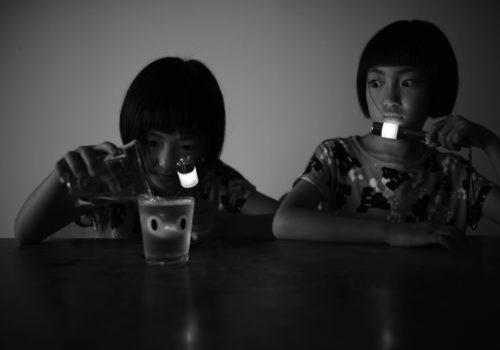The Japanese T3 Photo Fair Asia held its first edition from Friday, October 18, to Monday, October 21. In the vast space of Midtown Yaesu, it brought together Japanese and Korean galleries, before expanding next year to include other historical scenes emerging from the Asian continent.
Walking through a fair remains a subjective exercise. Whether you are a collector or a passionate enthusiast, you move from gallery to artist, from artist to artwork, as if jumping from stage to stage in a festival, with your ears wide open and your mind alert for new discoveries. Reflecting on this experience inevitably leads to frustrating some while praising others, falling in love with certain works, and remaining blind to others.
Hiroshi Nomura at Poetic Scape Gallery (Tokyo)
The series “Doppelopment” by Hiroshi Nomura (Japan) is named after a contraction of two words: “Doppelgänger,” which refers to a hallucination of oneself as another, and “development,” recalling the idea of growth as well as photographic technique. At first glance, this coined term is anything but scholarly for Hiroshi Nomura.
The series exhibited by the Tokyo-based Poetic Scape gallery shows twin girls in everyday scenes: sometimes playing on the ground, other times exploring with a flashlight in hand. Back to back, they invite the viewer to play a game of “spot the difference.” They pose in the street, one focused on playing the piano while the other pulls a funny face. In essence, these are mundane scenes captured by Nomura with great simplicity, made slightly strange by the presence of the twins.
These joyful and loving twins stand in stark contrast to the eerie memory of the bloody sisters from The Shining. However, what may link them to Kubrick, and more so to the constant deception of photography, is that there are two in the image, but only one in reality. Through the game of double exposure, in a wonderfully exquisite arrangement (if one knows how to discern it, which I cannot), Hiroshi Nomura played with his daughter Hana to compose these fictitious scenes, drawing from the works of Diane Arbus and Shigeo Gocho. It’s an admirable work of tenderness, exquisite in its deceit.
John Yuyi, Emergence Sector: “Discover New Asia: Exploring Artistic Self-Discovery with Four Women”
John Yuyi, known as Chiang Yu-Yi (Taiwan), is one of the stars of contemporary fashion photography. Her brilliance was revealed through her series “Becoming Famous,” featuring celebrity faces adorned with stickers, followed by “Face Post,” where faces are marked with slogans and other saturation messages.
In the four prints showcased in the short but thoughtfully curated section dedicated to Asian artists of the “New Asia,” there is no saturation or abundance. Instead, there is a great sibylline blue sky uniting the pieces and a naked body in the foreground, divided into three parts: head, torso, and buttocks, with blurred silhouettes of naked bodies in the background following the body in the foreground like walkers on the slope of a hill. For some reason, the whole gives an impression of lightness, joy, and consequence-free eroticism, devoid of desire, other than the gesture of liberation.
Limb Eung Sik, “Masters Selection,” at Yeh Gallery (Seoul)
Born in Japan in 1912 and died in South Korea in 2001, Limb Eung Sik embodies through his images and photojournalistic approach the troubled history between his two countries. He is now considered a major figure in the history of Korean photography. Rightly so, as he was instrumental in bringing Edward Steichen’s exhibition “The Family of Man” to the National Museum of Modern and Contemporary Art in Seoul in 1957 (the exhibition gathered over 300,000 visitors!).
Initially a studio and portrait photographer, he became a field photographer during the Korean War (1950-1953). His images adopt a form of realism that blends the humanistic influences of Cartier-Bresson. His works are present in two locations within the fair: first, extensively through the Korean gallery Yeh, and also in a presentation curated by the fair director, Jeong Eun Kim.
Kijuki Kawada, PGI (Tokyo)
Photo Gallery International is one of the emblematic galleries of this fair. Alongside Emet Gowin, Edward Weston, and Harry Callahan, it champions great Japanese masters like Yasuhiro Ishimoto and Kijuki Kawada. The latter, founder of the VIVO collective in 1959 with Akira Sato, Akira Tanno, Shomei Tomatsu, Ikko Narahara, and Eikoh Hosoe, presents saturated works, mostly dark, contrasted with a brightly lit print of a female body surfacing from a swimming pool. This serves as a salute within an often turbulent yet insightful oeuvre.
Hideka Tonomura, Zen Foto Gallery (Tokyo)
The Arles public encountered Hideka Tonomura (Japan) this summer during the exhibition “Transcendence,” in the labyrinth of the Vague house. In my opinion, her installation remained the standout work of this myriad exhibition, with small prints in rich colors creating an installation full of gravity, raw in its portrayal of the body, commodified sexuality, the pains of daily life, and individual wanderings. Her somewhat elusive style, characterized by filters, saturated colors, flesh or blood hues, and a medical blue, combined with distance from the subject through movement and blur, gives her works a general impression of great whirlpool-like turmoil. The recent works shown by Zen Foto Gallery continue in this vein, maintaining the same sticky charm.
More information
















